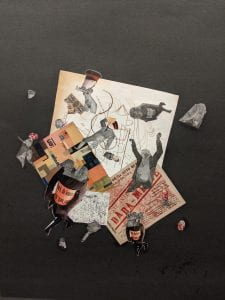

Image
Self-Portrait Score
Original: Self-Portrait
Place a mirror in front of you. Using a clean sheet of paper and a new pencil, draw what you see, sharpening as needed. Stop when your pencil disappears. Leave the drawing but remember to take everything else.
Final: Self-Portrait
Place a mirror in front of you so that you are looking at yourself without distraction. Using a clean sheet of paper and a new pencil, draw what you want without erasing. Sharpen as needed, stopping only when your pencil disappears. Leave the drawing but remember to take everything else.
This score was inspired by a lot of work stemming from East Asian Taoist and Buddhist art. The actual voice for the score was inspired by East Asian poetry. I wanted a piece that was very simple in concept, but difficult in execution. I wanted it to be a challenge for the performer, as well as a lesson of sorts. My main ideas were of introspection, self-concept, and self-healing. When I thought of this score, I intended for it to be repeatable, and meditative, and designed it as a form of meditation. In its first iteration, the main idea was that the performance should get more difficult as you draw as there is less you see to draw, and at this point you would need to search harder for what to draw. In the second iteration, after I attempted the performance myself, I realized that I wanted to make it a bit more intense of an experience, so I added the rule that you can’t erase, so everything you draw is permanent. During class, some comments were that the score was vague, which I intended, but I tightened it up a bit, adding the lines that the space should be free of distractions. Some people realized that by the way I worded it, that the performer didn’t need to draw themselves necessarily, so I took with that and changed it so they draw whatever they want and I also added that they need to see themselves in the mirror. After performing the score, I saw some additional themes of just the experience of life. Thinking about Dada and how they made equivalent both art and life, I thought about how the score was really about the experience of making art rather than the actual drawing itself, in the same way that perhaps life is more about the experience than about the actual content.
Rishi
In-Class Exercise: Berlin Collage
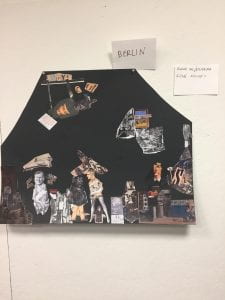
Artwork#4 Self-Intro
Game Description:
This is a text-based narrating game, there are 2 players, player 1 first answer a series of questions, and his/her answer will be the only choices for player 2, who must fill in the blanks from sentences popping up on the screen, the “story” is about a person who is introducing himself.
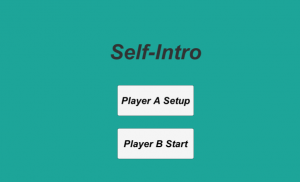

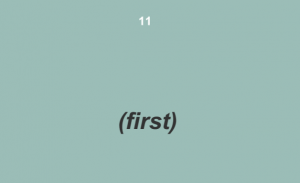
Artist Statement:
So the idea of this is that I want 2 players have 2 opposite feelings of the game, player 1, who is just answering the questions, will have free choices of answering all the questions, however for player 2, his only choices are provided by player 1, who just filled in those questions arbitrarily. (Note: player 1 won’t be told the fact that player 2’s choice was based on what player 1 filled, the game just asks player 1 to answer whatever he/she likes, and telling that will “help” player 2.)
More about the experience, I want the player 2 to feel that all the choices are totally dependent, frustration and struggle are what I am aiming for in this piece.
Inspiration & Iteration process:
Throughout the semester, I had been interrogating myself the same question again and again, that is, what is “experimental game”, well it seems easy to answer but I was struggled to find my own answer to this. I find it difficult for me to come out with an idea that can be approved by myself when I’m thinking of making a game just focuses on a certain aspect. For this project, at the beginning I started with the idea “I want to create a text-based game which player don’t make choices but write their own.” And apparently, it turns out someone had already done that before. But one thing I learned from that is I must make my goal more specific, more extreme, and with more strict design limitations, that is how I came out with this final version.
In the final version, I want player 2 to be frustrated and struggle to choose the word, additionally why I choose the story to be a self-introduction of a person is I think the answers player 1 answers, when they become choices for player 2 writing a self-introduction, it feels like player 1 is creating a “standard” for the character, I want to criticize the aspect that the standards created by other people may limits who you could became.
The first iteration was pretty frustrating for me because when I found out the ideas I came out had already been done, however I think it does happen a lot and it’s a good lesion for me, especially it gives me the chance to re-think about my ideas and make it more unique than before. It is also pretty much my overall learning experience/understanding throughout all 4 projects, that finding the way to make your idea expressive and unique.
Non-Sense Playtest iteration
2 players are playing “Reversi”, with additional rules:
About Reversi: https://en.wikipedia.org/wiki/Reversi#References
Rules:
- Each turn when a player finishes putting down the piece, name a sense/part of a body, from now on the opponent cannot use the part the player named. For example, eyes, nose, ears, leg, arm, mouth…as long as it makes sense to you and audiences. (Also only one part could be named each time, which means, for instance instead of saying vision, you can only name either left eye or right eye each time.)
- When the player was unable to play, and only when he/she admitted that, skip that player’s turn, and resets both players’ “state”.
- The “disable rule” only applies to the player when the piece touches player’s body.
Iteration process:
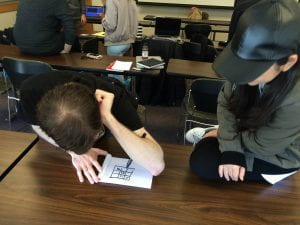
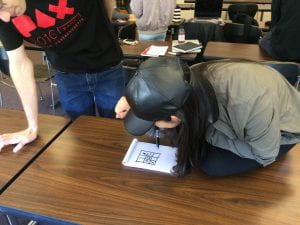
The initial idea was two players playing tic-tac-toe, a lot simpler than the final version playing reversi, but during the playtest the game ends quickly although there are some funny moments occurred during the gameplay. So I think playing a game with a little bit more complexity plus the rules added above would be doable.
During the playtest it seems when playing tic-tac-toe with these rules, occasionally players have to find the way to hold the pen, I found it very interesting and added the rule ” The “disable rule” only applies to the player when the piece touches player’s body.” to adapt the mechanic to the new version, it also gives people chances to play around with it.